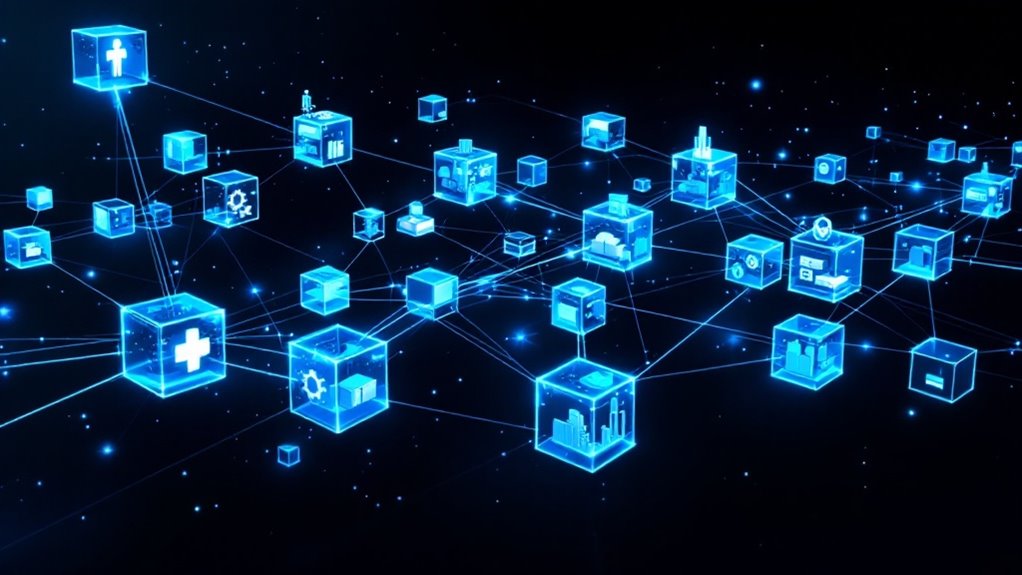Blockchain's impact stretches far beyond digital currencies, transforming how society handles trust and verification. From tracking farm-fresh produce to securing medical records, this technology creates unbreakable digital footprints across industries. Government agencies leverage it for transparent operations, while IoT devices use it to strengthen cybersecurity. Like a digital notary working tirelessly in the background, blockchain weaves an intricate web of accountability that promises to reshape our interconnected world.

While cryptocurrencies initially thrust blockchain technology into the spotlight, this revolutionary digital ledger system has quietly woven itself into the fabric of industries far beyond finance. Like a digital tapestry of trust, blockchain's immutable nature has transformed how organizations track products, verify identities, and secure sensitive information.
In the domain of supply chains, blockchain acts as an invisible thread connecting farmers' fields to grocery store shelves. Every crate of strawberries, every shipment of automobile parts, every batch of pharmaceuticals leaves digital footprints that can't be erased or altered. When contaminated lettuce appears on store shelves, retailers can trace its journey back to the source in minutes rather than weeks. The technology's immutable ledger ensures accurate tracking and accountability throughout the entire product journey. The system's distributed nodes work together to maintain and verify every transaction, making supply chain data virtually tamper-proof.
Healthcare providers, traditionally bound by paper trails and fragmented systems, are discovering blockchain's potential to unite patient data while maintaining ironclad privacy. Imagine a world where your medical history follows you seamlessly from doctor to doctor, yet remains more secure than ever. Meanwhile, pharmaceutical companies are using blockchain to wage war against counterfeit medications, creating an unbreakable chain of custody from laboratory to pharmacy. The technology's integration with smart contracts enables automated, secure sharing of medical records between authorized healthcare providers.
Government agencies, often criticized for bureaucratic inefficiency, are finding that blockchain can transform mundane processes into models of transparency. From voting systems that make fraud virtually impossible to public records that can't be altered by corrupt officials, blockchain is becoming democracy's digital guardian.
The Internet of Things, with its billions of connected devices, has found in blockchain a solution to its security nightmares. Smart homes, industrial sensors, and city infrastructure can now communicate with unprecedented security, while smart contracts automate everything from energy management to maintenance schedules.
As we stand at the threshold of this blockchain revolution, the technology's true potential extends far beyond digital currencies. It's becoming the invisible foundation of trust in our digital world, the silent notary of our transactions, and the incorruptible keeper of our records.
In an era where trust is increasingly scarce, blockchain offers something remarkable: a way to verify truth without relying on human integrity.
Frequently Asked Questions
How Does Blockchain Technology Ensure Data Privacy in Healthcare Applications?
Blockchain guarantees healthcare data privacy through cryptographic encryption, pseudonymization of patient identities, granular access controls, and smart contracts that enable patients to manage permissions for their medical information securely across networks.
What Programming Languages Are Most Commonly Used for Developing Blockchain Solutions?
Solidity dominates Ethereum development, while C++ powers Bitcoin and major cryptocurrencies. Java and Python are prevalent in enterprise solutions. Rust is gaining popularity for newer platforms like Solana and Polkadot.
Can Blockchain Systems Be Completely Integrated With Existing Enterprise Software?
Enterprise software can be integrated with blockchain systems through APIs, middleware, and specialized connectors. While complete integration is possible, it requires careful planning, custom development, and consideration of technical challenges.
How Much Energy Do Non-Cryptocurrency Blockchain Applications Typically Consume?
Non-cryptocurrency blockchain applications typically consume minimal energy, comparable to traditional databases. Proof-of-Stake networks and private blockchains use considerably less power than mining-based systems, often just basic operational energy requirements.
What Are the Scalability Limitations for Blockchain Implementation in Supply Chain Management?
Supply chain management faces scalability constraints including limited transaction speeds, growing data storage needs, network congestion, and integration challenges with existing systems. These limitations restrict large-scale deployment across complex global operations.









